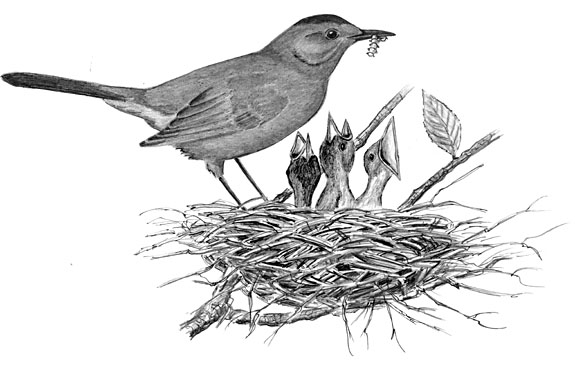
Dear Bird Folks,
We have a pair of catbirds nesting in the bushes next to our house. They sometimes sit on a nearby planter and feed each other bugs. More recently they have been flying right into the bushes with the bugs, presumably to feed the babies. My questions are: Do they take care of their offspring together and do they mate for life? They seem so happy together.
-SAR, Brewster, MA
I’m with you, SAR,
I don’t know about the “happy together” part, but I really enjoy watching catbirds, too. Each spring when many other folks are falling all over themselves to see the first hummingbirds or orioles, I look forward to the arrival of the catbirds. You wouldn’t think that a capitalist pig like myself would care about a bird that I really can’t make money on. After all, catbirds don’t use birdhouses or eat birdseed. Nobody ever asks for a coffee mug or a T-shirt with a catbird on it. And I have yet to have anyone buy an expensive pair of binoculars because they want to get a good look at a catbird. There is absolutely no money in catbirds, yet they are one of my favorite…wait, no money? I must be an idiot. How could I possibly enjoy a bird like that? I’d better rethink this.
As soon the male catbirds arrive from their wintering grounds they find an exposed branch and start singing their huge array of babbling songs that may contain a hundred or more different phrases. A male’s territory is usually about an acre and he defends it by singing as loud as he can and by chasing away any other male that gets too close. When a female arrives he tries to chase her away too, but she, being a little more hip to the mating thing, doesn’t budge. She continues to brush off his attacks until he finally catches on. After a brief courtship the pair mates and starts thinking about building a nest. This is the point where the male catbird suddenly discovers that his new partner is bit of a control freak and his opinion doesn’t really matter much anymore. Welcome to marriage, Mr. Catbird.
Even though the male may help by gathering a bit of material, the entire construction of the nest is done by the female. The only thing he is allowed to do is stand around and act mildly interested. After the nest is completed, the female continues her controlling ways by insisting on laying every single egg herself. Boy, talk about being set in her ways. The female lays one egg each day until four blue eggs are laid, at which time she starts incubating them, and again refuses to let her partner do any of it. Although he has been pushed aside, the male continues trying to please his mate and will sometimes land near the nest site with a juicy bug. Upon seeing the offering the female pops off the nest and willingly accepts the free meal. This mate feeding is probably the very behavior you were lucky enough to witness, SAR.
Other times the female will leave the eggs for brief periods to find her own food. The minute she leaves, the male jumps up on the edge of the nest and stands guard over eggs…but he never sits on them. He doesn’t want to get yelled at by the old lady. Once the eggs have hatched the male suddenly becomes important in the process, as he brings both the babies and the brooding mom a steady supply of lovely, fresh insects. For the next few weeks both parents bring food to the hungry kids, but that stops just after the young birds leave the nest, at which time they become the responsibility of the father. The female abandons her first family and goes to work building a new nest, laying another batch of eggs and starting a second family. It should be noted that, as far as we know, the father of the first family and the father of the second family are the same bird. The female catbird wants it made clear that she may be a bit controlling, but she’s not a hussy.
For the most part catbird couples are monogamous during the nesting season, but that’s where it ends. On the wintering grounds the male and female catbirds occupy and defend separate territories. By the time spring rolls around again the two birds have all but forgotten about each other. Many catbirds don’t even return to the same breeding territory, and even if they do return there is no reason to seek out the same mate. I mean really, what’s the point? They’re catbirds; they all look the same. It’s not as if a hot catbird, with real short feathers and ruby red mandibles is going to suddenly show up and start turning heads. With catbirds, it’s whatever gets the job done.
I agree with you, SAR, catbirds are really enjoyable birds to watch, but I think it’s our interpretation of their actions that makes them appear, as you say, “happy together.” And by the way, it’s not the catbirds; it’s The Turtles who are Happy Together. You might not understand that last line, but somewhere there’s an old rocker from the 60s having a flashback like you won’t believe.